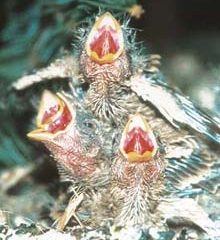Life Sciences and Chemistry
Articles and reports from the Life Sciences and chemistry area deal with applied and basic research into modern biology, chemistry and human medicine.
Valuable information can be found on a range of life sciences fields including bacteriology, biochemistry, bionics, bioinformatics, biophysics, biotechnology, genetics, geobotany, human biology, marine biology, microbiology, molecular biology, cellular biology, zoology, bioinorganic chemistry, microchemistry and environmental chemistry.

Mother Finch Controls Baby’s Sex to Increase Survival Odds
Most mothers-to-be must simply hope for healthy offspring. But female house finches tip the odds in their babies’ favor by pre-determining their gender, a new study suggests. According to a report published in the current issue of the journal Science, enterprising mother house finches adjust the sex and growth of their offspring to account for the order in which the eggs are laid, thereby reducing the mortality of their sons and daughters by 10 to 20 percent.
Alexander Badyaev of the Univer

Introducing the biology of the future: Researchers at CellZome AG and EMBL publish record-breaking analysis of a cell’s proteome
Scientists are calling it “biology of the next generation,” and a major step towards transforming information from genome projects into applications such as the discovery of new drugs. Today researchers from Heidelberg have announced the completion of a large-scale study of the “molecular machines” formed by nearly two thousand proteins in a living cell.
In a paper published in the current edition of Nature, a team of scientists from the biotechnology start-up company CellZome and the Europe

BSE in sheep: first estimates of human death toll
BSE in sheep: first estimates of human death toll
The first attempt to estimate the human health risk from possible BSE infection of the British sheep flock is published today by researchers from Imperial College, London.
They show that while the present risk of Creutzfeldt-Jakob disease (vCJD) from eating sheep could be greater than that from cattle, the overall historical risk from sheep is much less than that from cattle.
The research, which is reported in the jo

A virus may contribute to certain psychiatric disorders
A virus that causes a fatal brain disease in horses and sheep may be linked to certain mental disorders in man, medical experts heard today (Wednesday 09 January 2002) during a joint meeting of the European Societies of Clinical and Veterinary Virology and the Society for General Microbiology at the Royal College of Physicians, London.
“Recent investigations have again stimulated highly controversial discussions as to whether Borna disease virus can infect humans and lead to psychiatric diso

Armour-plated fish and the evolution of dentists
The discovery of small spikes lining the mouths of primitive fossil fish reveal surprising new details about how early animals fed. New research published today in a Royal Society paper sheds light on how teeth evolved.
Primitive fish did not have jaws or fins but were covered in rigid bony scales and resembled small armour-plated submarines. Dr Mark Purnell, a palaeontologist at the University of Leicester, has discovered that heterostracans, one of the most important groups of these early

`Plant aspirin’ offers hope against crop diseases
The discovery by French scientists that cotton plants produce a kind of ‘plant aspirin’ in response to bacterial infection could lead to new ways of fighting crop diseases.
Researchers led by the French Institute of Research for Development (IRD) found that salicylic acid — which has a chemical structure very similar to that of aspirin — and jasmonate acid are both released by cotton plants in response to infection by the bacterium Xanthomonas .
The two plant hormones play